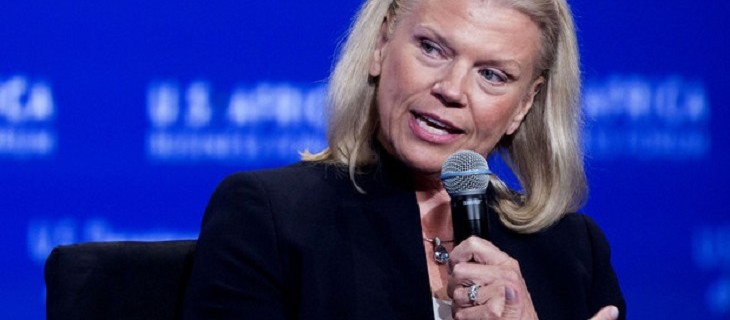The pressure is building for IBM's Ginni Rometty to revive the company or risk confronting calls for more radical steps — like a major breakup.
International Business Machines Corp. (IBM) surprised investors yesterday by scrapping its 2015 forecast and projecting that earnings will decline this year, the first drop since 2002. The shares plunged to a three-year low.
That's left investors and analysts asking: How can Chief Executive Officer Rometty give a 103-year-old tech giant new life? IBM has so far failed to move into growth areas like cloud computing fast enough to make up for a decline in its older hardware and software businesses. Other technology companies that haven't moved quickly enough have taken more drastic action this year, with Hewlett-Packard Co. saying it'll split in two and EBay Inc. planning to spin off PayPal.
IBM's executives “really now have their back against the wall in terms of growth and strategy,” said Daniel Ives, an analyst at FBR Capital Markets. “The jury's still out in terms of how successful she will be.”
What Rometty needs is growth, which is easier said than done. While IBM's big future bet is on cloud computing, that business is only about 3 percent of the company's annual revenue. Meanwhile, services and software are no longer the savior they once were to make up for declining hardware demand.
With more customers demanding software and services delivered via the cloud, there is less overlap with IBM's salesforce, said Amit Daryanani, an analyst at RBC Capital Markets. After the divestitures that Rometty has overseen, now may be the time to consider a breakup that will have more impact.
Breakup Idea
“Are you better off having an IBM services and an IBM software-plus-hardware company as standalone entities?” Daryanani said. “That seems to be a more interesting discussion to have than what can they spin off at this point.”
For now, IBM is mostly facing more urgency to add business customers, cut jobs and other expenses, divest more low-margin businesses and make more acquisitions to prove it can catch up to the industry's widespread changes. After 10 straight quarters of falling revenue, IBM wants to shift its software portfolio to the cloud, where customers host technology in remote servers instead of onsite. The company also needs to battle pricing pressure on the services business, IBM's biggest.
To do that, the company will need to move faster and lure more than its typical Fortune 100 customers for growth, like small- to medium-sized businesses, said FBR's Ives. That will pit IBM against rivals like Salesforce.com Inc. and Amazon.com Inc.
Acquisition, Split
Rometty may also need to look to competitors like Oracle Corp. or Hewlett-Packard for inspiration for a transformative acquisition — or a breakup, according to RBC and Solaris Asset Management LLC.
Across the board, these legacy companies are learning that businesses can't continue as usual as they struggle to keep pace with technological advancements. In the name of nimbleness, Hewlett-Packard is splitting up; EBay is separating PayPal; and EMC Corp. is exploring strategic options that could include a full or partial sale, or a spinoff of VMware Inc.
One key difference is that IBM has essentially been pursuing a slow-moving breakup for the last decade, divesting assets like its PC business and low-end server unit, which were sold to Lenovo Group Ltd. in 2005 and 2014, respectively. Yesterday, IBM agreed to pay Globalfoundries Inc. $1.5 billion to take its money-losing chip-manufacturing division.
Those divestitures have removed $7 billion of annual revenue, which Rometty calls “empty calories.”
Reinventing IBM
When asked about the possibility of a split yesterday, Rometty was clear that the company benefits from have offerings like cloud services and data analytics integrated.
“Look, unlike many other companies, we have been aggressive about changing our company on our own, and this started years ago,” Rometty told CNBC. “We've taken our own actions to reinvent ourselves.”
As part of her mantra of transformation into a cloud- and data-focused company, IBM created a separate business around its Watson data analytics technology and is now doing the same with its cloud business.
“We have got to reinvent ourselves like we have done in prior generations,” she said on a conference call yesterday. She's trying to move a big ship, with more than 430,000 employees in 170 countries.
In a memo to those workers, Rometty emphasized her three-part plan to accelerate the company's turnaround: establishing a dedicated cloud business; introducing more flexible software offerings for customers and transforming the delivery of services; and streamlining the company to improve speed and agility.
Oracle Blueprint
Even if a breakup isn't the answer, at the very least a big acquisition may help IBM jump start its transformation and handle the shift in information technology, said RBC's Daryanani.
Oracle's new Co-CEO Safra Catz is on the hunt for applications companies to acquire to bolster areas where the software maker lags behind competitors. The company this year agreed to buy hotel and restaurant software company Micros Systems Inc. for $5.3 billion — more than double what IBM paid for SoftLayer.
Rometty had been attempting IBM's transformation while adhering to a long-term profit forecast laid out by her predecessor, Sam Palmisano, to hit $20 in adjusted earnings per share by 2015. That steady increase in income was praised by investors like Warren Buffett, and it's been a boon over time. Net income has triple since 2002, and gross profit margin has risen to more than 48 percent from 36 percent.
Read more: IBM's Rometty Under Pressure to Revive Tech Giant After Plunge






